German genre movies from Masters of Cinema
Eureka’s Masters of Cinema recently took a break from their perennial emphasis on Asian cinema to release three box sets of German genre films from the ’60s and ’70s. One of the most interesting aspects of these is the contrast the movies display between the different attitudes and demands made on filmmakers in West and East Germany at the height of the Cold War.
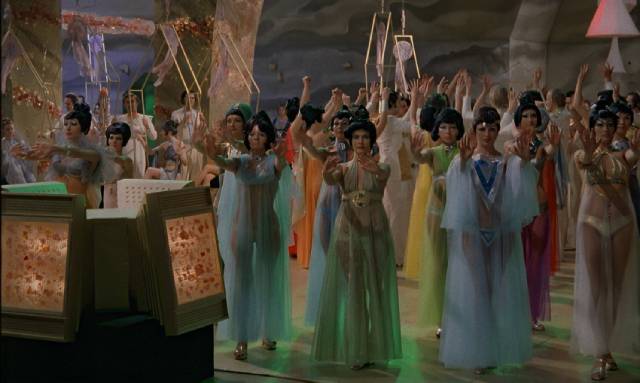
Strange New Worlds (Various, 1960-1976)
DEFA (Deutsche Film-Aktiengesellschaft) was the official studio of the German Democratic Republic, established immediately after the war in 1946 and serving the state’s need for propaganda cast in the form of popular entertainment. Of primary importance was displaying the positive, progressive aspects of socialism, for which socialist realism was the primary vehicle. But as with Hollywood’s underlying project of advocating for American Capitalism, the impulse to entertain couldn’t be completely contained and filmmakers would find themselves pushing against the bureaucrats who were always on the lookout for unacceptable ideas. While much of the studio’s output consisted of contemporary subjects (which will be on display in the upcoming Wrack and Ruin: The Rubble Film at DEFA set due in September), two particular genres appeared in the ’60s – “red westerns”, frequently adapted from the 19th Century novels of Karl May, which inverted the familiar mythology of the Hollywood western by foregrounding the indigenous peoples of North America and casting white colonizers as the bad guys; and science fiction, which by its nature was a more expensive proposition, resulting in only four big-budget movies in seventeen years.
Three of the four films in this set were previously released in a three-disk set from the DEFA Foundation in 2006, a fascinating artifact which I was happy to replace with Eureka’s upgraded Blu-ray edition. These colourful movies, while arguing for a better socialist future, all contain a fair amount of kitsch, distinguishing them from other notable Eastern bloc features – like Jindrich Polak’s Ikarie XB 1 (1963) and Jan Schmidt’s Late August at the Hotel Ozone (1967) from Czechoslovakia, or Andrei Tarkovsky’s Solaris (1972) and Stalker (1979) from Russia.

The Silent Star (1960) by Kurt Maetzig was conceived as an East German-Polish co-production in the mid-’50s. Based on the first science fiction novel by Stanislaw Lem (best known for Solaris), published in 1951, the script went through multiple versions before the authorities were finally satisfied and approved what was for the time a very high budget. In the film’s near future, most of the world seems to be unified under socialism, the chief exception being, not surprisingly, the United States. The crew assembled for a space mission includes Germans, Russians, Poles, Africans, Indians, Japanese and Chinese. They’re eventually joined by an American scientist who has gone against pressure exerted by U.S. authorities who are apparently uninterested in pooling scientific knowledge with the rest of the world.
The mission is triggered by the discovery of what appears to be a piece of alien technology which is deduced to be debris from a crash in Siberia in 1908 (previously misinterpreted as the explosion of a small asteroid). The team’s Indian and Chinese scientists manage to extract a fragmentary recording from the device and deduce that it came from Venus. Attempts to contact the planet by radio come to nothing, so the recently completed Mars rocket Kosmokrator is redirected to Venus. As in the familiar American space movies of the ’50s, the expedition encounters a meteor shower and the crew experience weightlessness. Nearing Venus, they run into radio interference which cuts them off from Earth, and the scientists decode more of the message, discovering that the crashed ship had been the vanguard of an invading force which was preparing to eradicate life on Earth in preparation for colonization.
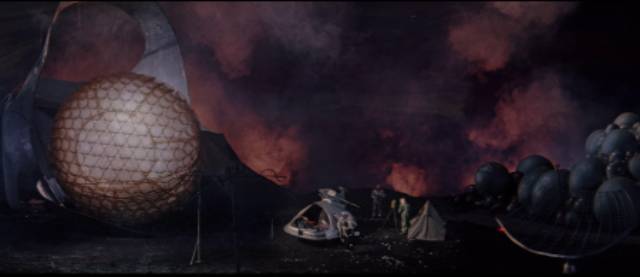
When they land, the crew discover a surreal landscape of charred forests and cities and make their way to what turns out to be a giant weapons system which would have destroyed life on Earth but instead backfired and destroyed the Venusian civilization. When the weapon is inadvertently reactivated, several crew members sacrifice themselves in disarming it, the survivors making their way back to Earth with a warning about the dangers of pursuing ever-greater weapons.
While sets and effects may not be convincing, the production is lavish and colourful; the design of the sets for the ship interior and the surface of Venus are something like Bava’s designs in Planet of the Vampires. Lem was unhappy with the adaptation, which he found heavy-handed and preachy, but the film does manage to achieve its aim of proving that DEFA was capable of matching what the West had been doing for the past decade in movies produced George Pal and others which combined optimism for the future with warnings about dangerous trends in the present.
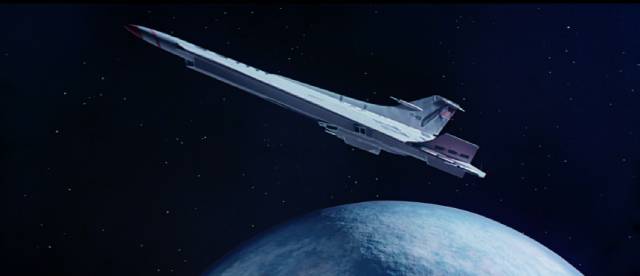
By the end of the ’60s, Stanley Kubrick had changed the nature of filmed science fiction. The serious tone and oblique storytelling of 2001: A Space Odyssey (1968) had done away with the more prosaic, gung-ho adventures of the ’50s and the pulpier aspects of more serious movies like Byron Haskin’s Robinson Crusoe on Mars (1964) and Franklin J. Schaffner’s Planet of the Apes (1968). There were a number of Eastern bloc responses to the technical and thematic challenges posed by Kubrick, most notably Andrei Tarkovsky’s Solaris. At DEFA, one of the studio’s main directors, Gottfried Kolditz, embarked on their first sci-fi epic since The Silent Star. The most impressive aspects of Signals: A Space Adventure (1970) are the set design and extensive model work, which both attempt to emulate Kubrick’s masterpiece. Shot in 70mm, the spaceship interiors are large and elaborate, with a lot of effort put into evoking weightlessness with its attendant disorientation as up and down no longer have a clear meaning.
The models are impressive – the main ship has a rotating centrifuge structure to create artificial gravity – although the effects are slightly undermined by overly bright, flat lighting, more reminiscent of Gerry and Sylvia Anderson than Kubrick. Less successful is sluggish pacing and a structure which uses multiple flashbacks to fill in the characters’ back stories, as well as oddly discordant tonal shifts; the main story, involving the loss of an exploration vessel in the vicinity of Jupiter and a captain’s efforts to find the wreck because his wife was on board, is strangely contrasted with sequences in which some of the characters frolic on a sunny beach, walking in the surf upside down on their hands as they chat about space travel. I assume the hand-walking is supposed to reflect some aspirational impulse eventually fulfilled by the experience of weightlessness, but otherwise these scenes are just an odd distraction.
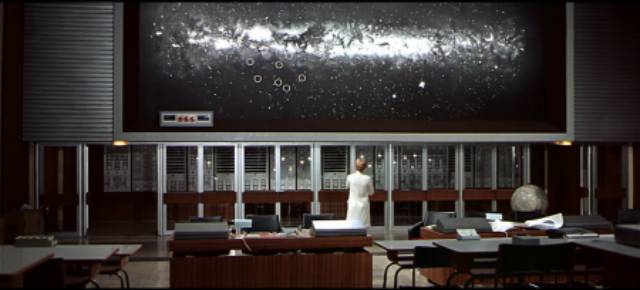
Signals was followed by Eolomea (1972), directed by Hermann Zschoche, more explicitly set in a seemingly peaceful socialist future. In rapid succession eight ships vanish from a sector of the solar system and their orbital base falls silent. While there are heated debates at the space council, the scientist in charge suspends all activity in that sector, clashing with a crusty older scientist who seems strangely unconcerned even though his daughter was on one of the ships. As the bureaucrats attempt to decipher the mystery, the narrative is interrupted with flashbacks to a romance between the lead scientist and an astronaut now working on an isolated asteroid with a man whose son also disappeared with the missing ships.
It’s eventually revealed that some time ago messages were received from somewhere outside the solar system, indicating that there is intelligent life on a distant planet named Eolomea and that the older scientist has been involved in an unauthorized plan to send an expedition of intrepid younger people to investigate, hoping that the astronaut at the asteroid station will join the group as their navigator. Less impressive visually than Signals, and dramatically rather flat, there are vague echoes of William Cameron Menzies’ Things to Come in the contrived conflict between a stodgy, unadventurous bureaucracy and a younger generation eager to get out and explore the universe, but this is dealt with in a perfunctory way which lacks any real conflict. On top of which, there’s an embarrassingly retro robot which would’ve been more at home in an old Republic serial.
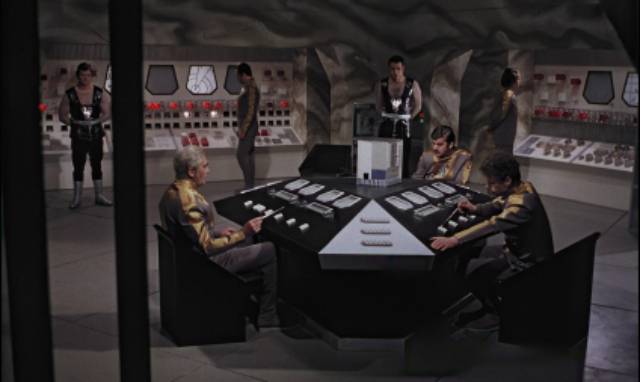
Gottfried Kolditz returned for DEFA’s final sci-fi epic in 1976. In the Dust of the Stars seems more Star Trek than 2001, with a notable increase in the kitsch factor and a more prominent emphasis on class and politics. A spaceship responds to a call for help and lands on the planet Tem 4; some kind of force interferes with their descent, and the crew are met with suspicion by the locals. These are a decadent bunch who deny sending a distress signal and seem to spend their time partying like ancient Romans in a Hollywood epic, or the youth culture in Michael Anderson’s Logan’s Run (1976), which was made at the same time. What the crew eventually discover is that these people are actually from another planet, having come here and enslaved the native population who are now kept in underground mines extracting the planet’s resources. The socialist critique echoes H.G. Wells’ The Time Machine and George Pal’s 1960 adaptation, with the spaceship’s crew aligning with the oppressed workers … although the movie ends ambiguously without a clear resolution, though the workers have been given a glimpse of the possibility of an uprising.
Hardly a serious political tract, the movie’s considerable entertainment value comes from the way it revels in the decadence – the tacky set and costume design, a surprising amount of nudity, and most of all the outrageously camp performance of Ekkehard Schall as the Chief of the colonizers, far outdoing Ralph Richardson’s blowhard warlord in Things to Come. Best-known for his theatrical work with Berthold Brecht, Schall revels here in the excess permitted by the fantasy context as he flirts with the ship’s captain and tortures members of her crew. The captain is the other highlight, played with great charm by the Czech actress Jana Brejchova.
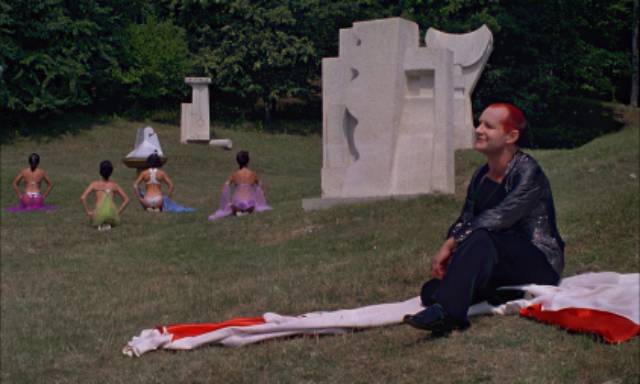
Although none of these films rises to the level of what science fiction was capable of at the time (the pinnacle being 2001 and Solaris), they’re interesting examples of state-funded production which display the tensions inherent between the dictates of socialist realism and the narrative demands of fantasy. All four films seem compromised, having been made by filmmakers embedded in the state system – in contrast with Tarkovsky who somehow managed to use state resources to create much more personal films (which inevitably ran into problems with the bureaucrats who were unable to rein him in). The set is a collection of colourful curiosities, given vivid transfers and plenty of contextual extras, including new audio commentaries and almost three hours of new and archival interviews, video essays and newsreel clips.
*

Eureka’s other two sets present a total of twelve features from Artur Brauner’s CCC Film production company, which had been established immediately after the war in order to reestablish (West) German production after more than a decade of Nazi control. Brauner, born into a Jewish family in Lódz, had escaped with his parents and siblings when Germany invaded Poland and spent the war in the Soviet Union, emigrating to Berlin at the war’s end. His first film, Sag’ die Wahrheit (1946), actually repurposed a comedy which had been in production at the end of the Nazi era, but his ambition was to make serious films and in 1948 he produced Morituri, about a group of concentration camp inmates who escape and survive precariously in a forest as they wait for the Soviet army to defeat the Nazis. Audiences, however, weren’t ready to confront recent history so directly and, after Nazi sympathizers vandalized theatres, it was virtually impossible to screen the film. Having lost a lot of money, Brauner quickly determined that any serious productions had to be supported by others designed specifically to appeal to a broad popular audience.
Through the ’50s, CCC (Central Cinema Compagnie-Film GmbH) supported occasional serious dramas with a string of releases centred on crime or comedy, bringing back a number of directors who had fled to Hollywood – minor figures like Gerd Oswald and Kurt Neumann, as well as big names like Robert Siodmak, William Dieterle and, biggest of all, Fritz Lang, who was lured with the promise that he could finally make his own version of The Indian Tomb, an epic which he had co-written in 1921 only to have it taken from him by producer Joe May. Personally important to Lang, the two-part film still garners mixed opinions for its artificial theatricality and problematic themes of Orientalism and colonialism. When viewed as a lush adventure rooted in 19th Century attitudes, however, it’s one of Lang’s most audacious and visually striking works.
Lang was less enthusiastic about the prospect of reviving one of the crowning achievements of his early career, although he eventually succumbed to Brauner’s urging. For the producer, resurrecting Dr. Mabuse was personally important because seeing The Testament of Dr. Mabuse (1933) as a teenager had inspired his ambition to get into filmmaking. Despite his reservations, Lang rose to the challenge; while the original Mabuse, in a two-part silent serial in 1922 and the sound sequel in 1933, foreshadowed Germany’s descent into the political gangsterism of Nazism, the new film depicted the lingering traces of fascism in post-war Germany and its influence on Cold War paranoia.
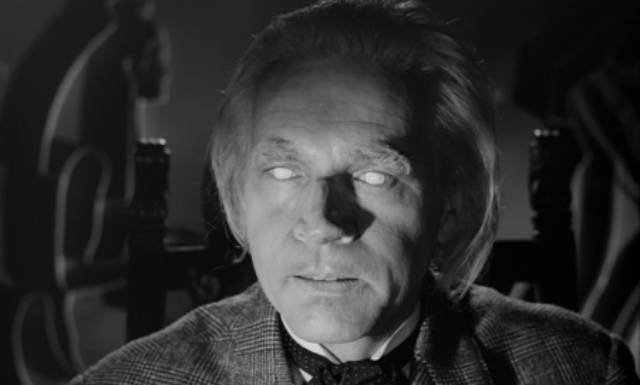
Mabuse Lives! (Fritz Lang et al., 1960-64)
Die 1000 Augen des Dr. Mabuse (The 1000 Eyes of Dr. Mabuse, 1960) was Fritz Lang’s last film as a director – declining health and failing eyesight made it impossible for him to get any subsequent projects into production; his final work was as an actor in Jean-Luc Godard’s Le Mepris (1963). As in Testament, Mabuse is no longer a specific man but rather a toxic force contaminating society, nihilistic and criminal (like fascism itself), assuming many disguises, although currently he’s embodied in the figure of Dr. Jordan, who also appears as blind clairvoyant Peter Cornelius, and finally as Mabuse himself, all played by Wolfgang Preiss. As Cornelius, Mabuse taunts the police by offering clues to his own criminal schemes in the form of psychic “visions”. Arrayed against the villain are Kommissar Kras (Gert Fröbe), Interpol agent Hieronymous B. Mistelzweig (Werner Peters), disguised as an annoying insurance salesman, and American industrialist Henry B. Travers (Peter van Eyck), who is drawn into Mabuse’s plans when he rescues a seemingly suicidal woman named Marion Menil (Dawn Addams). The focus of the complicated plot, in which no one is quite what they seem, is the Hotel Luxor in Berlin, an actual building erected by the Nazis and full of surveillance equipment which had once allowed the regime to spy on and blackmail influential people, now repurposed by Mabuse for his own plans to achieve world domination.
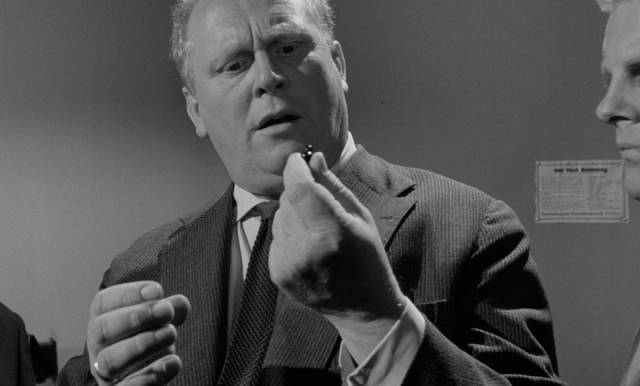
Lang had lost none of his skill in image-making and the film builds a powerful atmosphere of paranoia. Having all but invented the modern spy movie – following in the footsteps of Louis Feuillade with Spiders (1919), the Mabuse films and Spies (1928) – his revival of Mabuse in 1960 helped pave the way for the flood of thrillers which would follow the release of Dr. No (1962), with their escalating arsenal of increasingly fanciful gadgetry in the hands of supervillains. The mutual influence of Mabuse on James Bond and back again was reflected in the series of films produced by Brauner over the next four years, not entirely to Mabuse’s advantage. Without Lang’s continuing participation, and with a strong infusion of pulp, the subsequent five Mabuse movies settled firmly into derivative B-movie territory.
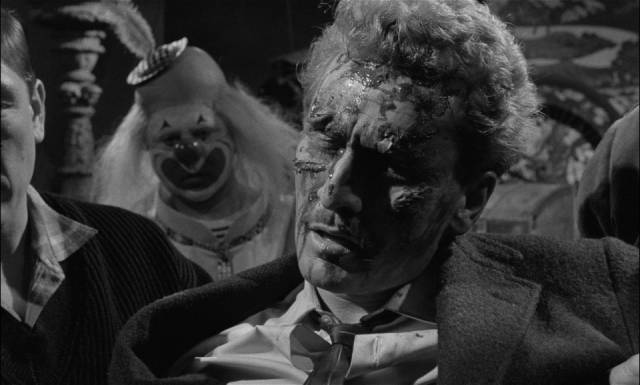
Which is certainly not to say that they are unentertaining. Mabuse himself, following Lang’s conception in his 1933 film, becomes less an actual person and more an idea, a representative of social contagion, a nihilistic carrier of fascist schemes which moves from one human host to another; in the original silent serial, he was a master of disguises who could move freely through every social stratum, but in the later films he literally possesses various people, using them as puppets to carry out his plans. And after Lang’s final film, he uses increasingly fanciful devices to achieve his aims, making it difficult for the police and various American agents to derail his schemes.
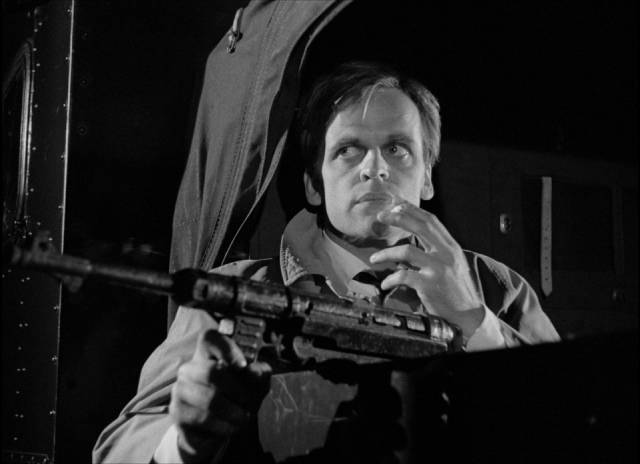
In The Return of Dr. Mabuse (1961), directed by Harald Reinl, one of Germany’s most successful genre filmmakers, Mabuse brainwashes prison inmates into an army of automatons; in The Invisible Dr. Mabuse (1962), also directed by Reinl, he steals an invention which enables him to create an army of invisible minions; Werner Klingler stepped into Reinl’s shoes for a remake of the 1933 film, The Testament of Dr. Mabuse (1962), in which the mad criminal is confined to an asylum, drafting endless plans which are carried out by the asylum’s director who is under the madman’s hypnotic sway; the next film, Scotland Yard Hunts Dr. Mabuse (1963), directed by the lesser-known Paul May, firmly blends the Mabuse series with the popular Krimi genre, relocating the action to London where Mabuse possesses yet another professor to carry out his plans; the final film in the series, The Death Ray of Dr. Mabuse (1964), directed by Hugo Fregonese, jumps on the Bond bandwagon, seeming to rush out some elaborate underwater action sequences a year before the release of Thunderball (1965), as Mabuse sets out to steal yet another weapon of mass destruction to facilitate his plans for world domination.
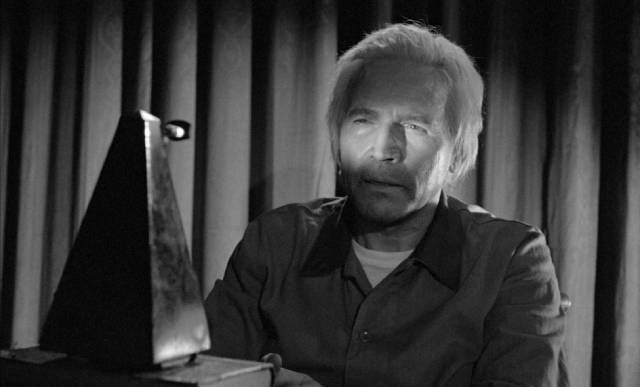
By the end, the character and concept of Mabuse has drifted far from Lang’s original conception, following trends rather than setting them. As the series passed from one director to another, so actors came and went. Preiss was something of a constant although in Scotland Yard he only appears briefly as Mabuse’s ghost and in Death Ray he’s only seen in stock footage. Gert Fröbe reappeared in Return and Testament, though not as Kommissar Kras, but rather as Inspector Lohmann, the policeman from M (1933) and the original Testament (played back then by Otto Wernicke). Peter van Eyck appeared as two different characters – in 1000 Eyes and Scotland Yard; Lex Barker was FBI agent Joe Como in both Return and The Invisible Dr. Mabuse; Werner Peters appeared as four different characters, while Walter Rilla showed up as two different characters both named Professor Pohland. With the films being made in quick succession, there’s definitely a feeling that characters and plot points are being recycled – Lang’s final film feels like the work of a master director who still has something to say, while the five films which followed are essentially disposable product turned out quickly to fill theatre seats until the next thing came along.
*
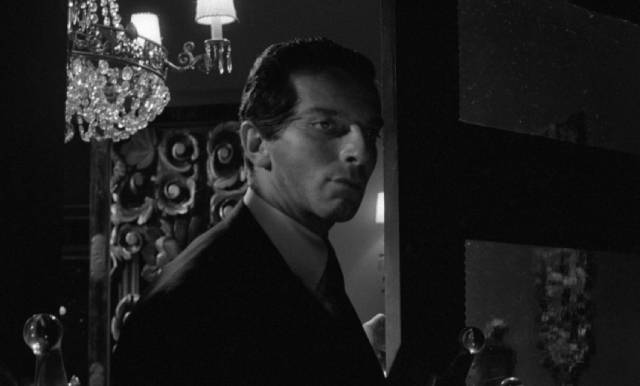
Terror in the Fog: The Wallace Krimi at CCC (Various, 1963-64)
That next thing was more than likely to be a Krimi. Shortened from Kriminalroman, something like a German version of the Italian giallo, this genre emerged from Rialto Film’s series of adaptations based on novels by the prolific British writer of thrillers Edgar Wallace, which were made at the same time as Merton Park’s Edgar Wallace Mysteries in England, though on a bigger scale. Rialto, which bought the rights to most of Wallace’s novels, produced thirty-nine features between 1959 and 1972, their box office success naturally attracting Arthur Brauner’s attention. With Edgar Wallace pretty much tied up by Rialto, Brauner turned to the author’s son Bryan Edgar Wallace, who had followed in his father’s footsteps, and traded on the name – though not necessarily on the source novels themselves. Like Rialto, CCC more often than not concocted entirely new stories, just borrowing the author’s name and a title for promotional purposes.
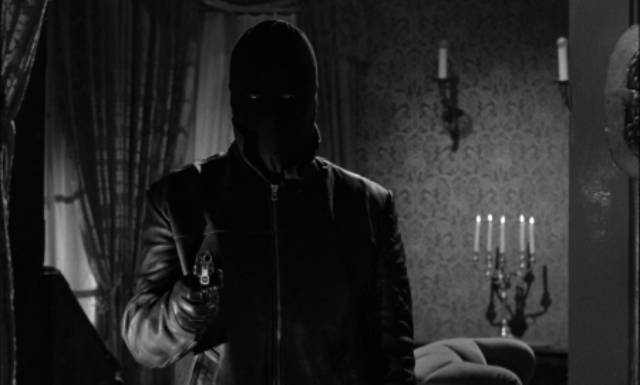
Eureka’s new set collects six of CCC’s productions, all of which overlap with the later Mabuse movies, two of which share writer Ladislas Fodor with the last five Mabuses. While the Merton Park movies have a prosaic, contemporary view of Britain, with characters and settings frequently drawn from middle class suburbia, the German Krimis are largely set in a strange alternate England where the period is imprecise – though seemingly contemporary, they also evoke Victorian and Edwardian Britain, drawing on foggy, gaslit memories of Sherlock Holmes as much as Wallace’s pulp novels (the year before Brauner produced his first Wallace adaptation, he had in fact updated Conan Doyle with Sherlock Holmes and the Deadly Necklace [1962], directed rather unenthusiastically by Terence Fisher).
Brauner ran into some problems with Rialto when he based his first Krimi on a novel by Edgar Wallace, placing him in direct conflict with the other company. So he switched to the works of Wallace’s son Bryan Edgar Wallace, frequently obscuring the first name in promotional materials in order to make potential ticket-buyers think they were getting something from the better-known Edgar. That first movie, The Curse of the Yellow Snake (1963), co-written and directed by Franz Josef Gottlieb, was adapted from Wallace’s 1926 novel The Yellow Snake, and belongs to the problematic “yellow peril” genre best exemplified by Sax Rohmer’s Fu Manchu novels, which posited a threat to Western (white) civilization from insidious Chinese madmen bent on world domination. As in most Fu Manchu movies, this one has white actors in yellow face perpetrating crimes with sadistic cruelty to further their ends.
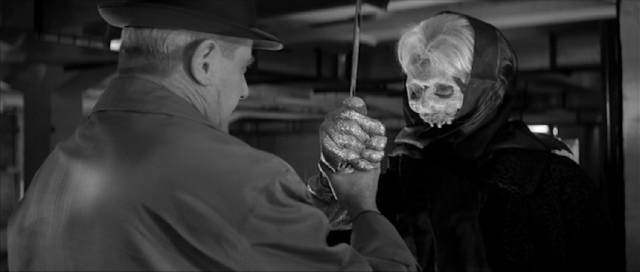
Eureka’s set skips over CCC’s first Bryan Edgar Wallace adaptation, The Secret of the Black Trunk (1962), and follows Yellow Snake with The Strangler of Blackmoor Castle (1963), which is much more atmospheric and particularly interesting as a proto-giallo. Directed by Reinl, the story takes place in and around a gloomy old English estate, giving the film an old-fashioned Gothic atmosphere while introducing a villain who bears a striking resemblance to the killers in Italian thrillers to come; masked and wearing black gloves, he not only strangles his victims, but also carves an “M” into their foreheads, seemingly in homage to Fritz Lang’s 1931 classic. On his trail are a Scotland Yard detective and an investigative reporter played by Reinl’s wife, Karin Dor.
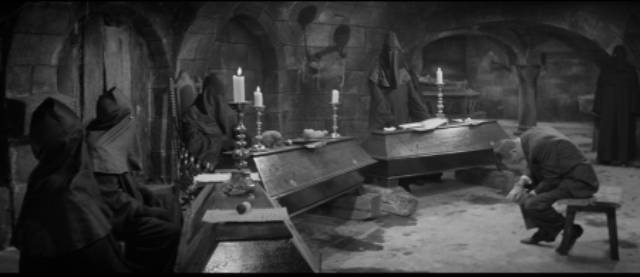
Next comes The Mad Executioners (1963), the first of two Wallace Krimis directed by Edwin Zbonek. Structurally the most interesting film in the set, it has two parallel narratives which eventually intersect, one of which turns out to revolve around a sci-fi concept and a mad scientist straight out of classic ’30s and ’40s Hollywood horror movies. In the first thread, a group of masked men hold secret tribunals (in a coffin-filled crypt) where they summarily try criminals who have escaped the law and sentence them to death, carrying out the executions in public places using a hangman’s rope “borrowed” from Scotland Yard’s Black Museum. Meanwhile, the city is being terrorized by a serial killer who murders young women and leaves their headless bodies in various parks. The two threads are eventually brought together in a narratively satisfying way during a breathless race to save another victim from the mad killer.
Another killer prowls the damp, foggy streets of London in The Phantom of Soho (1964), directed again by Gottlieb. This time the killer, masked and gloved, is targeting some prominent people with the crimes having some connection to a Soho nightclub. Again in classic giallo fashion, the murders involve a large knife and one of those investigating the killings is an amateur, here a woman crime novelist interested in getting first-hand experience with the reality of what her imagination has conjured up in her books. While giallo’s typical psycho-sexual motive is missing, the eventual discovery of a past event triggering revenge gives the moody narrative an effective conclusion.
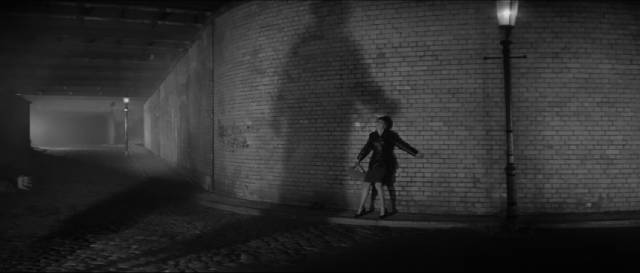
Edwin Zbonek returned for The Monster of London City (1964), the most self-referential of the films. While actor Richard Sand (Hansjorg Felmy) stars in a hit play based on the Jack the Ripper murders, someone is killing prostitutes in the East End. Is this a copycat inspired by the play, or has the strain of his nightly performance pushed Richard over the edge? A member of parliament (Fritz Tillman) is pushing through a bill to ban such displays of violence as entertainment, while unknown to him his niece (Marianne Koch) is dating the actor. Although there’s an awkward strain of humour added to the mix, the film is atmospheric and makes an interesting use of artifice which blurs the line between the stage violence and the real thing.
The final movie in the set is the most anomalous. The Racetrack Murders aka The Seventh Victim (1964), directed by Gottlieb, is the series’ most prosaic entry, much more like the Merton Park Wallace adaptations than the typical Krimi with its Gothic atmosphere. At the country estate of a racehorse breeder people start getting knocked off, beginning with a jockey. It all revolves around race-fixing and blackmail. The alternate title is justified by an inexplicably cruel final “gag” which serves no narrative purpose and leaves a sour taste.
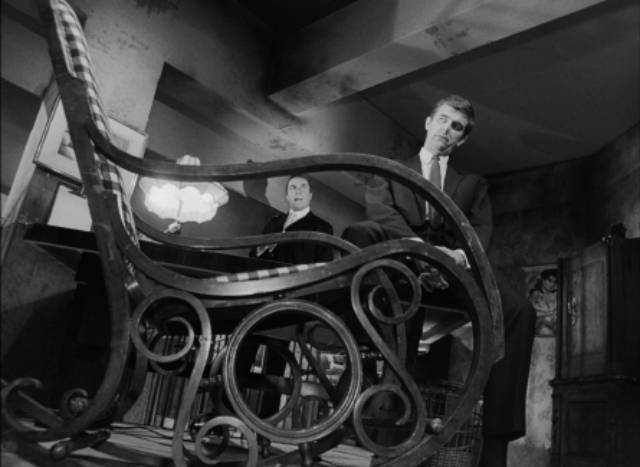
Five of the films are given 2K transfers, which look fine, with The Phantom of Soho only available in an older SD transfer, which nonetheless looks quite good and doesn’t really require Eureka’s on-screen apology. Each film gets an introduction from Tim Lucas, running approximately ten minutes, along with a brief six-minute introduction to Krimi as a genre. All six get a commentary from a familiar name – Kim Newman, Barry Forshaw, Kevin Lyons, Jonathan Rigby and Stephen Jones – and there’s an audio discussion between Lucas and Stephen R. Bissette on the Racetrack Murders disk. There’s a brief interview with Brauner’s daughter Alice and a video essay from Alexandra Heller-Nicholas about the links between Krimi and slasher movies.
*
All three sets are nicely packaged in a hard-box case and each comes with a 60-page book of notes and essays.
Comments